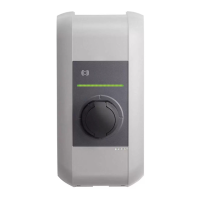
Do you have a question about the Keba KeContact KC-P30 Series and is the answer not in the manual?
| Protection degree | IP54 |
|---|---|
| Cooling | Natural convection |
| Charging power | 22 kW |
| Rated voltage | 400 V AC |
| Rated current | 32 A |
| Connection type | Type 2 socket |
| Communication interfaces | Ethernet, Modbus TCP, OCPP 1.6 |
| Output Power | 22 kW |
| Output Voltage | 400 V AC |
| Output Current | 32 A |
| Residual current monitoring | Integrated DC residual current protection (RCM DC 6 mA) |
Explains meaning of safety symbols like DANGER, WARNING, CAUTION, ESD, and Information for hazard and tip identification.
States the document describes KC-P30 operation and its scope, including validity for different series.
Details user requirements, intended use for electric vehicles, and installation guidelines for indoor/outdoor use.
Covers warranty conditions, permitted maintenance work, and the importance of retaining and following the manual.
Lists document topics covered and not covered, and provides a link for additional manuals and information.
Details critical safety precautions for installation, operation, and maintenance to prevent electric shock and fire hazards.
Advises on proper handling of the charging cable and cleaning to prevent damage to the station and property.
Identifies and describes visible components on the charging station's front panel, including LED bar and socket.
Explains the data found on the device's type plate, including serial number, technical specifications, and approvals.
Details how product designation determines charging station type and features, noting regional availability.
Describes optional features like the RFID reader for card authorization and the key switch for starting charging.
Details the function and color indications of the LED bar for displaying the charging station's operating status.
Explains the dot matrix LED display for energy meters, showing energy status, firmware details, and text messages.
Explains LED bar patterns and acoustic signals used to indicate authorization status and events.
Outlines the process of using RFID cards for authorization, including teaching-in master and slave cards.
Step-by-step guide to access the service button for preparing the charging station for RFID card management.
Instructions for teaching in the initial RFID master card, essential for managing slave cards.
Details the process of teaching in RFID slave cards using the master card.
Explains how to delete all taught-in RFID cards, noting individual deletion is not possible.
Describes RFID card administration in a charging network via a master station.
Explains how a key switch starts a charging process, with the key removable after initiation.
Guides on initiating a charging session based on authorization status (LED indication) and method.
Provides steps to properly conclude a charging session by ending it on the vehicle and disconnecting.
Lists common errors, their possible causes, and recommended remedies for charging station issues.
States the station is essentially maintenance-free but requires regular visual inspection of sockets, connectors, and housing.